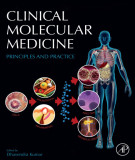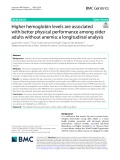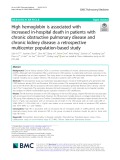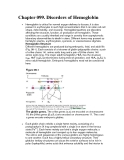
Abnormal hemoglobin
-
Part 2 book "Clinical molecular medicine - Principles and practice" includes content: Molecular genetic management of epilepsy, the human leukocyte antigen system in human disease and transplantation medicine, disorders of abnormal hemoglobin, coagulation and bleeding disorders,...and other contents.
 292p
292p  oursky06
oursky06
 17-10-2023
17-10-2023
 1
1
 1
1
 Download
Download
-
Anemia is the most common hematological abnormality among older adults, and it is associated with decreased physical performance. But the role of hemoglobin in the absence of anemia remains unclear. Thus, this study aimed to assess the impact of hemoglobin levels on physical performance in Brazilian older adults without anemia.
 9p
9p  vinobelprisen
vinobelprisen
 26-03-2022
26-03-2022
 18
18
 5
5
 Download
Download
-
Chronic kidney disease (CKD) is a common comorbidity of chronic obstructive pulmonary disease (COPD). Although high hemoglobin (Hb) is detrimental to CKD patients, its relationship with poor outcomes in the COPD population has not been reported. This study aimed to investigate the relationship between high Hb and inhospital mortality and to explore reference Hb intervals in patients with COPD and CKD.
 8p
8p  vimaine2711
vimaine2711
 26-03-2021
26-03-2021
 18
18
 2
2
 Download
Download
-
A total of 140 dogs were diagnosed with hepatobiliary disorders based on clinico, hemato-biochemical and diagnostic imaging. Out of which, 32 dogs were diagnosed with diffuse parenchymal disorders with ascites, 32 dogs with diffuse parenchymal disorders without ascites, 24 with focal parenchymal disorders and 52 with biliary tract disorders. Significantly decreased hemoglobin and total erythrocyte count with elevated total leucocyte count and neutrophil count were common hematological abnormalities.
 6p
6p  trinhthamhodang4
trinhthamhodang4
 22-03-2020
22-03-2020
 5
5
 1
1
 Download
Download
-
Th i s book wi 11 be of great interest to anyone concerned with animal feeds and feeding programs whether one is studying bovine, porcine, equine, avian or lower vertebrate (fish and eel) nutrition. This information is critical to the success of an animal feeding program. Somet imes the di fference between a successful and a failing program can be traced to mineral deficiencies which cause either abnormal growth, reduced milk production, interrupted fertility and breeding, compromised immune system integrity and/or decrement in normal hemoglobin concentration.
 0p
0p  cronus75
cronus75
 14-01-2013
14-01-2013
 46
46
 4
4
 Download
Download
-
Red blood cells contain hemoglobin. Hemoglobin helps red blood cells carry oxygen from the lungs to other parts of the body. People with normal hemoglobin have mostly Hemoglobin A in their red blood cells. People with sickle cell disease have mostly sickle or Hemoglobin S (Hb S) in their red blood cells. Hb S is an abnormal type of hemoglobin. In people with sickle cell disease, Hb S causes the red blood cells to change from a round shape to a sickle or banana shape. Also, Hb S causes the red blood cells to become rigid and sticky. This leads...
 13p
13p  connhobinh
connhobinh
 10-12-2012
10-12-2012
 74
74
 2
2
 Download
Download
-
Hemoglobin is critical for normal oxygen delivery to tissues; it is also present in erythrocytes in such high concentrations that it can alter red cell shape, deformability, and viscosity. Hemoglobinopathies are disorders affecting the structure, function, or production of hemoglobin. These conditions are usually inherited and range in severity from asymptomatic laboratory abnormalities to death in utero. Different forms may present as hemolytic anemia, erythrocytosis, cyanosis, or vasoocclusive stigmata. ...
 24p
24p  socolanong
socolanong
 25-04-2012
25-04-2012
 56
56
 3
3
 Download
Download
-
Table 103-4 Risk Stratification for Idiopathic Myelofibrosis A. Prognostic factorsa Hemoglobin 30,000/µL Number of prognostic factors Risk group Median survival (months) 0 Low 93 1–2 High 17 B. Prognostic factorsb Hemoglobin 1% Number of prognostic factors Risk group Median survival (months) 0–1 Low 99 2–3 High 21 C.
 5p
5p  thanhongan
thanhongan
 07-12-2010
07-12-2010
 80
80
 2
2
 Download
Download
-
Bone Marrow The bone marrow is usually normal or hypercellular, but in 20% of cases it is sufficiently hypocellular to be confused with aplasia. No single characteristic feature of marrow morphology distinguishes MDS, but the following are commonly observed: dyserythropoietic changes (especially nuclear abnormalities) and ringed sideroblasts in the erythroid lineage; hypogranulation and hyposegmentation in granulocytic precursors, with an increase in myeloblasts; and megakaryocytes showing reduced numbers or disorganized nuclei.
 4p
4p  thanhongan
thanhongan
 07-12-2010
07-12-2010
 74
74
 4
4
 Download
Download
-
Hemoglobin E HbE (i.e., α2β226Glu - Lys) is extremely common in Cambodia, Thailand, and Vietnam. The gene has become far more prevalent in the United States as a result of immigration of Asian persons, especially in California, where HbE is the most common variant detected. HbE is mildly unstable but not enough to affect RBC life span significantly. The high frequency of the HbE gene may be a result of the thalassemia phenotype associated with its inheritance. Heterozygotes resemble individuals with mild β-thalassemia trait.
 5p
5p  thanhongan
thanhongan
 07-12-2010
07-12-2010
 89
89
 3
3
 Download
Download
-
Unstable hemoglobins occur sporadically, often by spontaneous new mutations. Heterozygotes are often symptomatic because a significant Heinz body burden can develop even when the unstable variant accounts for a portion of the total hemoglobin. Symptomatic unstable hemoglobins tend to be β-globin variants, because sporadic mutations affecting only one of the four α-globins would generate only 20–30% abnormal hemoglobin. Hemoglobins with Altered Oxygen Affinity High-affinity hemoglobins [e.g.
 5p
5p  thanhongan
thanhongan
 07-12-2010
07-12-2010
 70
70
 4
4
 Download
Download
-
Sickle Cell Syndromes The sickle cell syndromes are caused by a mutation in the β-globin gene that changes the sixth amino acid from glutamic acid to valine. HbS (α2β26 Glu→Va1) polymerizes reversibly when deoxygenated to form a gelatinous network of fibrous polymers that stiffen the RBC membrane, increase viscosity, and cause dehydration due to potassium leakage and calcium influx (Fig. 99-3). These changes also produce the sickle shape. Sickled cells lose the pliability needed to traverse small capillaries.
 5p
5p  thanhongan
thanhongan
 07-12-2010
07-12-2010
 68
68
 2
2
 Download
Download
-
Harrison's Internal Medicine Chapter 99. Disorders of Hemoglobin Disorders of Hemoglobin: Introduction Hemoglobin is critical for normal oxygen delivery to tissues; it is also present in erythrocytes in such high concentrations that it can alter red cell shape, deformability, and viscosity. Hemoglobinopathies are disorders affecting the structure, function, or production of hemoglobin. These conditions are usually inherited and range in severity from asymptomatic laboratory abnormalities to death in utero.
 5p
5p  thanhongan
thanhongan
 07-12-2010
07-12-2010
 86
86
 8
8
 Download
Download
-
Classes There are five major classes of hemoglobinopathies (Table 99-1). Structural hemoglobinopathies occur when mutations alter the amino acid sequence of a globin chain, altering the physiologic properties of the variant hemoglobins and producing the characteristic clinical abnormalities. The most clinically relevant variant hemoglobins polymerize abnormally, as in sickle cell anemia, or exhibit altered solubility or oxygen-binding affinity. Thalassemia syndromes arise from mutations that impair production or translation of globin mRNA, leading to deficient globin chain biosynthesis.
 5p
5p  thanhongan
thanhongan
 07-12-2010
07-12-2010
 54
54
 4
4
 Download
Download
-
Epidemiology Hemoglobinopathies are especially common in areas in which malaria is endemic. This clustering of hemoglobinopathies is assumed to reflect a selective survival advantage for the abnormal RBC, which presumably provide a less hospitable environment during the obligate RBC stages of the parasitic life cycle. Very young children with αthalassemia are more susceptible to infection with the nonlethal Plasmodium vivax. Thalassemia might then favor a natural protection against infection with the more lethal P. falciparum.
 5p
5p  thanhongan
thanhongan
 07-12-2010
07-12-2010
 74
74
 4
4
 Download
Download
-
The absence of the spleen has minimal long-term effects on the hematologic profile. In the immediate postsplenectomy period, leukocytosis (up to 25,000/µL) and thrombocytosis (up to 1 x 106/µL) may develop, but within 2–3 weeks, blood cell counts and survival of each cell lineage are usually normal.
 7p
7p  konheokonmummim
konheokonmummim
 03-12-2010
03-12-2010
 72
72
 2
2
 Download
Download
CHỦ ĐỀ BẠN MUỐN TÌM




























